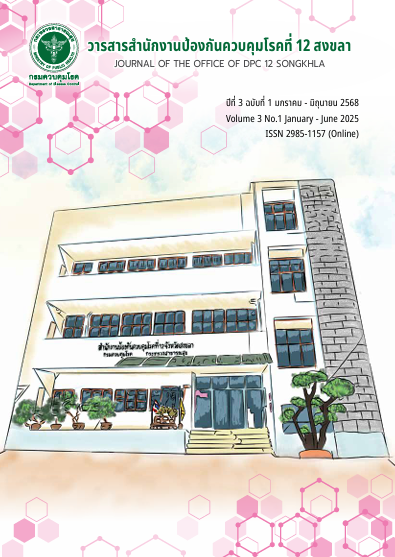Investigation Report on Work-Related Lower Back Pain in Healthcare Personnel: A Case Study from the Occupational Medicine Department of a Tertiary Hospital in Southern Thailand
Keywords:
occupational disease, lumbar disc herniation, ergonomics, healthcare personnel, patient liftingAbstract
This case investigation was conducted by an occupational medicine physician from the Division of Occupational Medicine following the diagnosis of a healthcare worker in a surgical
intensive care unit with a herniated lumbar disc with nerve root compression-a condition potentially associated with repetitive physical exertion and improper working postures. The objective of this report is to conduct a case-specific investigation of lumbar disc herniation with nerve root compression by examining the relationship between occupational tasks and disease development, and to propose preventive strategies for musculoskeletal disorders in at-risk
populations. This descriptive study followed the ACOEM Practical Guidelines (2018) for investigating work-related illnesses. Data were collected through a comprehensive medical and occupational history, direct on-site observation of work activities, and ergonomic risk
assessments using standardized evaluation tools. The findings revealed that the healthcare worker’s tasks involved frequent forward bending, trunk twisting, and repeated manual patient handling-postures identified as high-risk for lower back injuries. Using a clinical prediction rule for diagnosing work-related low back pain in healthcare professionals, the subject scored 8 out of 13, indicating a moderate level of risk. Additionally, an exposure assessment based on the
Criteria for Determining the Work-Relatedness of nonspecific Low-Back Pain yielded a score of 14, corresponding to a 59% probability that the condition was work-related (above the 50% threshold for occupational attribution). Based on these findings, it is recommended that
mechanical assistive devices be used during patient handling, training in proper body mechanics be provided, and workplace environments be ergonomically adjusted to support safer working conditions. These interventions may be applicable to other healthcare workers performing
similar tasks.
Keywords: occupational disease, lumbar disc herniation, ergonomics, healthcare personnel, patient lifting
References
โยธิน เบญจวัง, วิลาวัลย์ จึงประเสริฐ. อาการปวดหลังส่วนล่างจากการทำงาน. ใน: มาตรฐานการ
วินิจฉัยโรคจากการทำงานฉบับเฉลิมพระเกียรติเนื่องในโอกาสมหามงคลเฉลิมพระชนมพรรษา 80 พรรษา
ธันวาคม 2550: สำนักงานกองทุนเงินทดแทน สำนักงานประกันสังคม กระทรวงแรงงาน; 2550.
-54.
Nachemson A. The effect of forward leaning on lumbar intradiscal pressure. Acta orthop
scand. 1965;35:314-28.
Wilke HJ, Neef P, Caimi M, Hoogland T, Claes LE. New in vivo measurements of pressures
in the intervertebral disc in daily life. Spine (Phila Pa 1976). 1999;24(8):755-62.
Ellapen TJ and Narsigan S. Work Related Musculoskeletal Disorders among Nurses:
Systematic Review. J Ergonomics. 2014;S4:S4-003.
Yin-gang Zhang, Zhengming Sun, Zhi Zhang, Jian Liu, and Xiong Guo. Risk Factors for
Lumbar Intervertebral Disc Herniation in Chinese Population: A Case-Control Study.
SPINE. 2009;34(25):E918–E922.
Kuijer PPFM, Verbeek JH, Seidler A, Ellegast R, Hulshof CTJ, Frings-Dresen MHW, et al.
Work-relatedness of lumbosacral radiculopathy syndrome: Review and dose-response
meta-analysis. Neurology. 2018;91(12):558-64.
Sun W, Yin L, Zhang T, Zhang H, Zhang R, Cai W. Prevalence of Work-Related
Musculoskeletal Disorders among Nurses: A Meta-Analysis. Iran J Public Health.
;52(3):463-75.
Schröder C, Nienhaus A. Intervertebral Disc Disease of the Lumbar Spine in Health
Personnel with Occupational Exposure to Patient Handling-A Systematic Literature
Review and Meta-Analysis. Int J Environ Res Public Health. 2020;17(13):4832.
S .Jorgensen, H .O .Hein and F .Gyntelberg. Heavy lifting at work and risk of genital
prolapse and herniated lumbar disc in assistant nurses. Occup Med. 1994;44:47-9
Kelsey JL, Githens PB, White AA 3rd, Holford TR, Walter SD, O'Connor T, et al. An
epidemiologic study of lifting and twisting on the job and risk for acute prolapsed
lumbar intervertebral disc. J Orthop Res. 1984;2(1):61-6.
Alpantaki K, Kampouroglou A, Koutserimpas C, Effraimidis G, Hadjipavlou A. Diabetes
mellitus as a risk factor for intervertebral disc degeneration: a critical review. Eur Spine J.
;28(9):2129-44.
Shiri R, Karppinen J, Leino-Arjas P, Solovieva S, Varonen H, Kalso E, Ukkola O, ViikariJuntura E. Cardiovascular and lifestyle risk factors in lumbar radicular pain or clinically
defined sciatica: a systematic review. Eur Spine J. 2007;16(12):2043-54.
Leino-Arjas P, Solovieva S, Kirjonen J, Reunanen A, Riihimäki H. Cardiovascular risk factors
and low-back pain in a long-term follow-up of industrial employees. Scand J Work
Environ Health. 2006;32(1):12-9.
Kaila-Kangas L, Leino-Arjas P, Riihimäki H, Luukkonen R, Kirjonen J. Smoking and
overweight as predictors of hospitalization for back disorders. Spine (Phila Pa 1976).
;28(16):1860-8.
Judith I. Kuiper, Alex Burdorf, Monique H.W. Frings-Dresen, P. Paul F.M. Kuijer, Freek
LÖtters, Dick Spreeuwers, et al. Criteria for determining the work-relatedness of
Nonspecicfic low-back pain. Amsterdam: Coronel Institute of Occupational Health; 2004.
แสงดาว อุประ. เครื่องมือช่วยวินิจฉัยโรคปวดหลังส่วนล่างจากการทำงานสำหรับผู้ปฏิบัติงานใน
โรงพยาบาล [วิทยานิพนธ์ปรัชญาดุษฎีบัณฑิต]. กรุงเทพฯ: มหาวิทยาลัยธรรมศาสตร์; 2563.
สำนักงานกองทุนเงินทดแทน. แนวทางการวินิจฉัยกลุ่มอาการปวดหลังส่วนล่างจากการทำงาน. สำนักงาน
ประกันสังคม. 2 มีนาคม 2548.
National Institute for Occupational Safety and Health. Back Belt- Do they prevent injury?
[Internet]. 1996 [cited 2024 November 14]. Available from:
Downloads
Published
How to Cite
Issue
Section
License
Copyright (c) 2025 Journal of the Office of DPC 12 Songkhla

This work is licensed under a Creative Commons Attribution-NonCommercial-NoDerivatives 4.0 International License.
วารสาร TCI อยู่ภายใต้การอนุญาต Creative Commons Attribution-NonCommercial-NoDerivatives 4.0 International (CC BY-NC-ND 4.0) เว้นแต่จะระบุไว้เป็นอย่างอื่น โปรดอ่านหน้านโยบายของเราสำหรับข้อมูลเพิ่มเติมเกี่ยวกับการเข้าถึงแบบเปิดลิขสิทธิ์ และการอนุญาต


